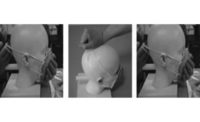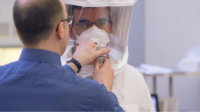Researchers at the National Institute for Occupational Safety and Health (NIOSH) are studying ultraviolet (UV) energy as a way to disinfect disposable respirators so that healthcare providers could reuse them during emergency situations, if they were in short supply. At certain doses, UV energy can inactivate or kill bacteria, viruses, and other germs so that they cannot cause disease. During an epidemic, respirator demand could be between 1.7 billion and 3.5 billion, according to a recent peer-reviewed article.
The researchers take coupons (large pieces punched out from actual respirators) and mount them in holders to maintain their size and shape, assuring all samples are the same. The coupons are then placed in a calm air chamber where they are exposed to an aerosolized (highly resistant) bacterial spore. The researchers then split the coupons into two groups: controls that are not UV exposed and those that will be UV exposed. The coupons that will be exposed are put in a UV exposure chamber where they receive well-controlled doses of UV energy. All coupons are then placed in individual tubes with liquid and shaken to collect the spores. The liquids are spread on a culture plate for the spores to grow, the spores are counted, and comparisons are made between the controls and the coupons exposed to UV to understand the effects of UV exposures on inactivation of the spores. Results of this process will show if respirator disinfection via the UV exposure is effective and if respirators can withstand UV exposures before noticeable effects on filtering efficiency, strength, and strap performance occur.
Applying UV Energy to disinfecting ambulances
In a related study, NIOSH researchers are studying UV energy’s ability to disinfect ambulances quickly. Currently, the main way to clean surfaces is to use approved disinfectants to wipe them, which can be difficult and time-consuming, particularly during the pressures of an ongoing disease outbreak.
In one ambulance studied, the researchers built a portable UV-disinfection system that can be shared in several other ambulances. In a second ambulance, they installed a permanent UV-disinfection system that workers could operate when the ambulance is empty or when driving. Germ tests showed that both systems disinfect surfaces reasonably quickly. Future research includes further testing to see how well the UV systems work and what their limitations might be. Researchers are also developing a programmable UV robot that they could more easily tailor to fit different ambulance models.


